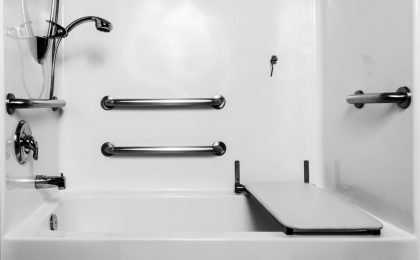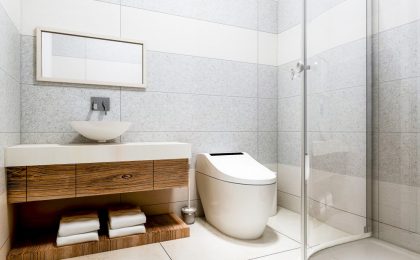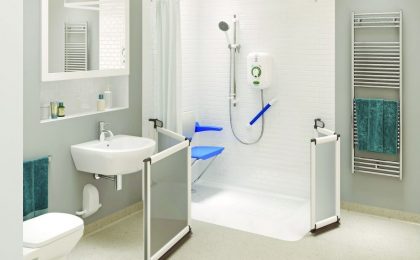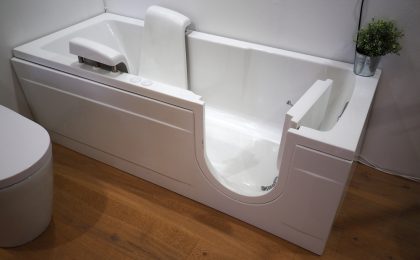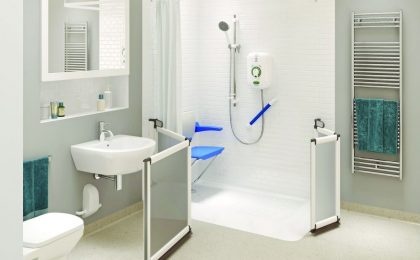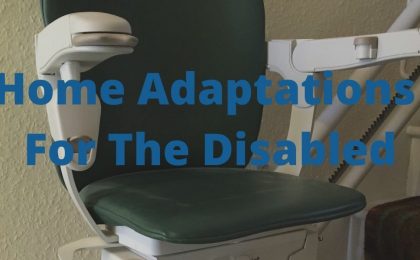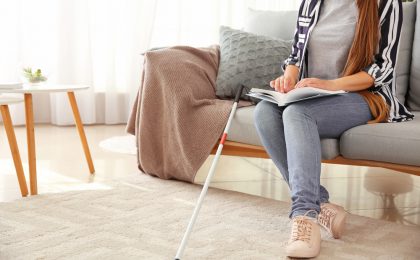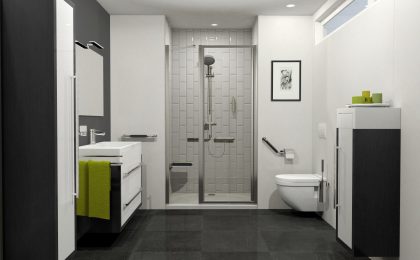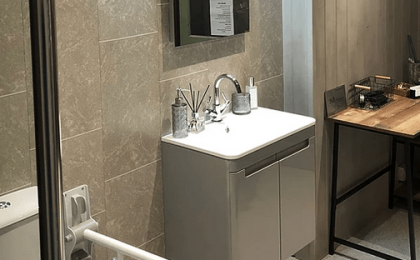A Guide To Disabled Showers
If you have a disability, it can be difficult and confusing when searching for a disabled shower to suit your needs. There are many different choices and features to decide between. At Age Care Bathrooms, we have constructed this helpful guide to navigate you through the features and equipment you will need for your disabled shower. If you have any additional queries, don’t hesitate to contact us.
When it comes to disabled showers, there are many different types of showers you can have to accommodate your level of mobility. Here are a few things to consider when deciding which type would be best for you:
- The size of your current shower/bathroom
- What type of disability you have and what equipment/features you will need
- Your size and weight
- Style choice
- Who else will be using the shower
These factors are important when designing your disabled shower, but it’s worth remembering that Age Care Bathrooms have installed thousands of mobility bathrooms over the years and have a wealth of knowledge when it comes to designing and installing disabled showers.

Intro to Disabled Showers
When it comes to disabled showers, there are many different types of styles you can have to accommodate your level of mobility. Here are a few things to consider when deciding which type would be best for you:
- The size of your current shower/bathroom
- What type of your disability you have and what additional features you will need
- Your size and weight
- Style choice
These factors are important when designing your disabled shower, but it’s worth remembering that Age Care Bathrooms have a wealth of knowledge when It comes to designing and installing disabled showers.
What Is A Low Level Shower?
A low level shower (also known as a walk-in shower) is suited to those who have limited mobility but are able to take a small step into the shower. Low-level shower trays are up to 40mm high in height, so they don’t create a tall floor obstacle. This type of disabled shower is great for small bathrooms as their size and fit can be adjusted to meet the requirements of your space.
Low-level showers are one of the most popular disabled showers as the general versatility of the shower covers a range of needs and requirements. If you believe you could benefit from a low-level shower, or want to find out more about this style, please get in touch with Age Care Bathrooms.


Over-Bath Showers
By having an over-bath shower it can make a huge difference, also it can be very cost-effective and still allow other household users to shower in the same way as before. It involves installing the shower controls just above the tabs and makes it easier for you to reach them whilst sitting.
There will be some plumbing involved, so you might experience some minimal disruption to your home. However, we aim to complete the installation of your new over-bath shower as soon as possible. In most cases, we can complete the installation within 1 day.
We also recommend using a board or seat that fits across your bath and investing in grab rails, to help you in and out of the bath. We would only recommend using this type of shower if you are comfortable with climbing over the bath.
What is a Level Access Shower?
A level access shower (usually featured in mobility wetrooms) is a shower where there is no tray/lip at all to step over. Instead, the shower tray is level with the bathroom floor, removing all floor-level hazards.
This form of disabled shower provides users with essentially, a large shower, with no restraints on space, tight walling and other movement impairments. The installation of a level-access shower can keep you safe whilst bathing and also gives you peace of mind.
Due to the space available and the easy accessibility, this type of disabled shower is perfect for wheelchair users, enabling efficient methods of entry and exit.

Shower Cubicles
Shower cubicles are designed to be more accessible than climbing in and out of a bath. When it comes to picking which type would be more suited to your needs, then you have a few options. There is the corner cubicles which fit in the corner of your bath, ideal for minimum space. Full cubicles can be placed anywhere in your bathroom, they have three sides and a cubicle door. Age Care Bathrooms always recommend that you add grab rails in any of your cubicle showers. One again, our amazing team can help you pick the equipment and fittings that suit your needs. This may be adding seats, shower controls, anti slip flooring and many more.
Disabled Showers – Enquire Today!
Using a Shower chair Correctly – Avoiding Accidents
Baring mobility issues may cause you to refrain from cleaning as much as you would hope to, due to the difficulty it may cause. Using a shower chair is safe and comfortable, here are a few things to consider when using a shower chair safety:
- Ensure that the shower chair is set firmly and does not wobble
- Have cleaning products, such as soap, within reasonable distance
- Lay anti-slip mats to refrain from accidents when exiting the chair
- Don’t make any sudden movements
- If the shower is for someone else, take them through the processs and then give them their own privacy, unless they need assistance
- Distribute weight accurately, refrain from sitting on the chair edge
Shower Units
When choosing your shower unit you have many options to fit your needs. You have a Thermostatic mixer shower that will preheat water from your boiler or hot water tank. They automatically compensate if the pressure changes. They also make sure you don’t get scalded if someone else in the house turns the cold water on. Also you can have Instant or electric showers, these are great for reducing fluctuation in water temperature and keep your showers at the right temperature.
Last we have a few different types of Shower unit controls, these are great for you to set your shower up to your needs. If you have sight loss you may wish to shortlist shower units that have achieved ‘RNIB approved’ endorsement. These showers are designed with those with sight loss specifically.

Entering & Exiting Disabled Showers
If getting in and out of the shower is not always easy, then it’s time to change that. We supply many different features and fits to help you with getting in and out of your shower/bath. Here are some of the features we offer.
-
GRAB RAILS help stabilise our customers and provide them with extra support around the bathroom. These are often placed on walls around the shower/bath area.
-
HORIZONTAL RAILS are great for both walk-in showers and baths. They can help you push up from a sitting position and also provide great support when sitting down.
-
VERTICAL RAILS can be placed around the bathroom for extra support. Having them next to a shower seat can be very helpful and will stop you from slipping.
-
SHOWER BOARDS are designed to fit over the top of your bath and act as a seat, so you can shower using your traditional setup. However, they don’t work with shower screens.
-
SWIVEL BATH SEATS fit over the bath and swivel inwards. They are great for back support and also act as an armrest. These seats are set in a fixed position and do not lower into the bath.
You can learn more about disabled showers and their features on our website, or you can get in touch with any questions.
Disabled Showers – Enquire Today!
Shower Stools, Seats and Chairs
Having somewhere to sit in your shower can make a big difference, not everyone will be able to support their own body or may be uncomfortable to do so. Here we have a range of different ways to sit in the shower. It is worth saying that you should always check to see if your shower tray or bath is capable of having a seat sat on it with the added weight of a person. You can discuss this with Age Care Bathrooms by getting in touch to see what tray/bath is most suited to you. Here are some of the different seats you can use:
-
SHOWER STOOLS come with non-slip feet and sometimes with back support and adjustable legs. They can be made out of different materials mostly plastic and come with either three or four legs.
-
WALL-MOUNTED SEATS come in two different categories, either static or hinged. Some come with back support and armrests, but you must enquire to see if there are any weight restrictions.
-
SHOWER CHAIRS come in all shapes and sizes and can come either static or mobile. All shower seats will come with rubber cups on the legs to prevent any slipping. You can have a shower chair with armrests and padded seating. Make sure to talk to our team about what shower chair you would like.
-
SHOWER CHAIRS with castor bases are ideal for mobility within showers and cubicles. These are designed to have metal frames and have plastic seats, they are generally smaller so take up less space.
-
SELF-PROPELLED WHEELED SHOWER CHAIRS are designed so you can propel yourself independently into a shower or cubicle. This chair can be operated by yourself or someone else pushing the chair and it can travel across most surfaces in your home.
Equipment Featured in Disabled Showers
It’s not only the shower that can make a difference to your use, it’s also the equipment you use too. Here is a list of different equipment that can help you and your specific needs:
-
SHOWERHEAD HOLDERS tend to be set in fixed positions in your existing showers, you can have adjustable shower head holders to set the showerhead to a height that suits your needs.
-
SHOWER SCREENS and enclosures can be portable or fixed and are great for wet rooms and walk-in showers. They come in a range of different configurations and help keep carers dry.
-
LONG-HANDLED BATHING AIDS are great to help you wash without having to reach and stretch which may cause discomfort.
-
LEG LIFTERS help you move your legs when seated on a chair or swivel chair over the rim of the bath. You use a reinforced strap with a loop and one end, then you physically lift your leg into the bath.
-
SHOWER STEPS help you with getting in and out of the bath with that little added height adjustment. They are not recommended for those who struggle with their balance, also we recommend using these on anti-slip flooring to prevent any slips or falls.
-
ANTI-SLIP PRODUCTS are great to provide you with that extra security when using your disabled shower. We have many different styles of anti-slip strips and we also supply different bath mats.

Shower Safety
Most doctors advise that the ideal shower temperature should be 41 degrees celsius. The best way to look at it is, if you see your skin getting red or flushed then the temperature is probably too high. You can get specific temperature gauges installed so you can find the optimum temperature.
Age Care Bathrooms are leading UK suppliers of disabled showers. We have wealth of knowledge and experience in this area and will be happy to discuss the many different options for you. So why not give Age Care Bathrooms a call to explore your options today or get in touch via email? Call 0800 808 5897.
For further details on our disabled showers and the installation process, contact our helpful team today!












